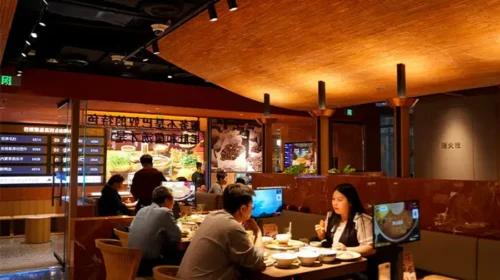Nongfu Spring founder casts spotlight on destructive price wars plaguing China

Billionaire Zhong Shanshan blamed low-cost e-commerce platform Pinduoduo, as well as short-video site Douyin, for the cutthroat competition
Key Takeaways:
- Nongfu Spring has criticized China’s cutthroat price wars, even as its own aggressive pricing strategy undermines its critique
- Revenue for the company’s core packaged water business fell 18.3% in the first half of 2024 as it suffered from a series of public relations setbacks
By Hugh Chen
Zhong Shanshan, founder of bottled water giant Nongfu Spring (9633.HK) and one of China’s richest men, has turned a spotlight on intensifying price wars that are an increasingly common feature in the country’s corporate landscape. His recent sharp comments underscore the destructive nature of aggressive price-cutting that has become a key survival strategy as demand slows with China’s decelerating economic growth.
During a Nov. 19 visit to a factory in Jiangxi province, Zhong made scathing remarks targeting low-cost e-commerce platforms, with special venom for Pinduoduo (PDD.US), the service that has sent shockwaves through the industry with its cut-to-the-bone prices. Zhong said “internet platforms are systematically depressing pricing structures … especially platforms like Pinduoduo, which inflict tremendous damage on Chinese brands and industries.”
Zhong gave voice to an issue that resonates with business leaders across a growing list of industries, namely, that prolonged price wars can critically undermine everyone’s health. Such constant price slashing not only erodes profit margins, but also undermines companies’ capacity to invest in product innovation and development.
Zhong isn’t alone in his criticism of Pinduoduo, which also operates the similar rock-bottom Temu cross-border e-commerce site targeting Western markets. The platform is widely criticized in China for leveraging its market dominance to drive down prices, prioritizing consumer savings at the expense of merchant profitability. Such an approach reached a breaking point earlier this year when several China-based merchants protested Temu’s aggressive pricing controls and punitive fine structures that effectively strip away their profits.
That said, Zhong’s critique also rings just slightly hollow given Nongfu Spring’s own aggressive pricing tactics in the bottled water market. The company launched its own aggressive price war earlier this year against one of its main rivals, China Resources Beverage (2460.HK), exposing a major contradiction in his public stance.
In fact, Zhong’s critique may also be a strategic attempt to divert attention from several challenges Nongfu Spring has faced this year. One of those occurred in February when Zhong was criticized for attending a memorial service for Zong Qinghou, one of China’s most famous early entrepreneurs known for founding rival Wahaha Group.
That incident reignited long-standing industry tensions, triggering online attacks that targeted Zhong personally. Critics raised sensitive issues, including allegations about his son’s foreign citizenship and claims that Nongfu Spring’s tea packaging displayed “Japanese-style elements” – a tactic often used by Chinese nationalists to attack people seen as trying to imitate foreigners.
Continuing his media offensive, Zhong escalated his public remarks at another event the next day on Nov. 20 when he criticized ByteDance founder Zhang Yiming, calling for responsible use of the company’s hugely successful platforms like Douyin and Toutiao. Zhong highlighted those platforms’ power in shaping public opinion, seemingly attempting to blame Nongfu Spring’s recent public relations challenges on influential big media platforms.
Nongfu’s own price war
During the first event where he lashed out at Pinduoduo, Zhong declared that Nongfu Spring would work to change its pricing structure and incrementally increase prices, indicating he would turn down the heat in his own industry’s price war. However, he conveniently overlooked the company’s own role in triggering that very price war.
In April, Nongfu Spring launched a new purified water line to complement the company’s traditional focus on spring water, pricing the new product below 1 yuan, or just $0.14, per bottle. This new product was packaged in bottles with green labels, positioned to differentiate them from the company’s traditional premium red bottle packaging, effectively introducing a new lower-cost alternative in the market.
The company’s premium red-bottle brand, traditionally priced around 2 yuan, has also seen significant price reductions in recent months, with prices dropping to as low as 1.1 yuan per bottle in some cities. Meanwhile, the newer green bottles are available for just 0.8 yuan in some places, according to a recent investigation by Southern Metropolis Daily.
Nongfu Spring’s aggressive pricing strategy has forced key competitors like China Resources Beverage, maker of the C’estbon brand, and Wahaha to roll out their own price reductions. For example, 12 bottles of C’estbon were priced at 11.9 yuan, equating to 0.99 yuan per bottle. And a similar pack of Wahaha purified water costs only 9.9 yuan, or 0.83 yuan per bottle. More broadly speaking, the price war has reduced the price of packaged water in China to less than 1 yuan per bottle, reverting to prices not seen for a decade.
It remains to be seen whether Zhong will follow through on his pledge to increase prices. That said, the current price-cutting strategy doesn’t appear to be having the desired effect. Even after the aggressive price reductions, revenue for Nongfu Spring’s core packaged drinking water business tumbled 18.3% in the first half of the year, dropping to 8.5 billion yuan ($1.2 billion), according to the company’s latest interim report.
Without critically examining its own pricing strategy, the company attributed this decline to extensive online attacks and malicious defamation targeting Nongfu Spring and Zhong since February, claiming such negative narratives “severely impacted the brand and sales.”
Nongfu Spring’s ability to turn down the heat in its price war will also depend on its competitors, particularly China Resources Beverage. The latter is relatively cash-rich after raising $649 million in a Hong Kong IPO last month, and may prefer to keep its prices at current levels to gain market share.
China Resources Beverage stock closed at HK$11.26 on Friday, representing a 22% drop from its IPO price, similar to a 27% decline so far this year for Nongfu Spring. That could reflect broader investor apprehension about the escalating price war in the bottled water market.
Despite Nongfu Spring’s difficulties, the company’s strong price-to-earnings (P/E) ratio of 28 is well ahead of China Resources Beverage’s 17, showing investors still favor the former. That preference may stem from Nongfu’s more diversified business model, with tea beverages emerging as a significant revenue stream for the company.
In the first six months of this year, Nongfu’s tea beverage segment grew by 59.5%, dramatically boosting that business 25.8% to 38% of the company’s revenue. In contrast, China Resources Beverage remains heavily reliant on bottled water, making it more vulnerable in the ongoing price war.
At the end of the day, there’s no denying that price wars have become a growing feature in China’s business landscape, spanning industries from consumer goods to automobiles and e-commerce. Nongfu Spring’s public critique of this strategy represents a potentially constructive first step to easing some of the pressure, but it’s far easier to say something than to back off – especially when your competitors may not follow suit.
Moreover, Nongfu Spring’s current approach of blaming others for its problems is unlikely to resolve its underlying issues. What the company truly needs is to transparently address its own market conduct, rebuild trust through genuine corporate responsibility, and demonstrate a commitment to sustainable business practices that prioritize long-term industry health over short-term competitive gains.
To subscribe to Bamboo Works free weekly newsletter, click here




